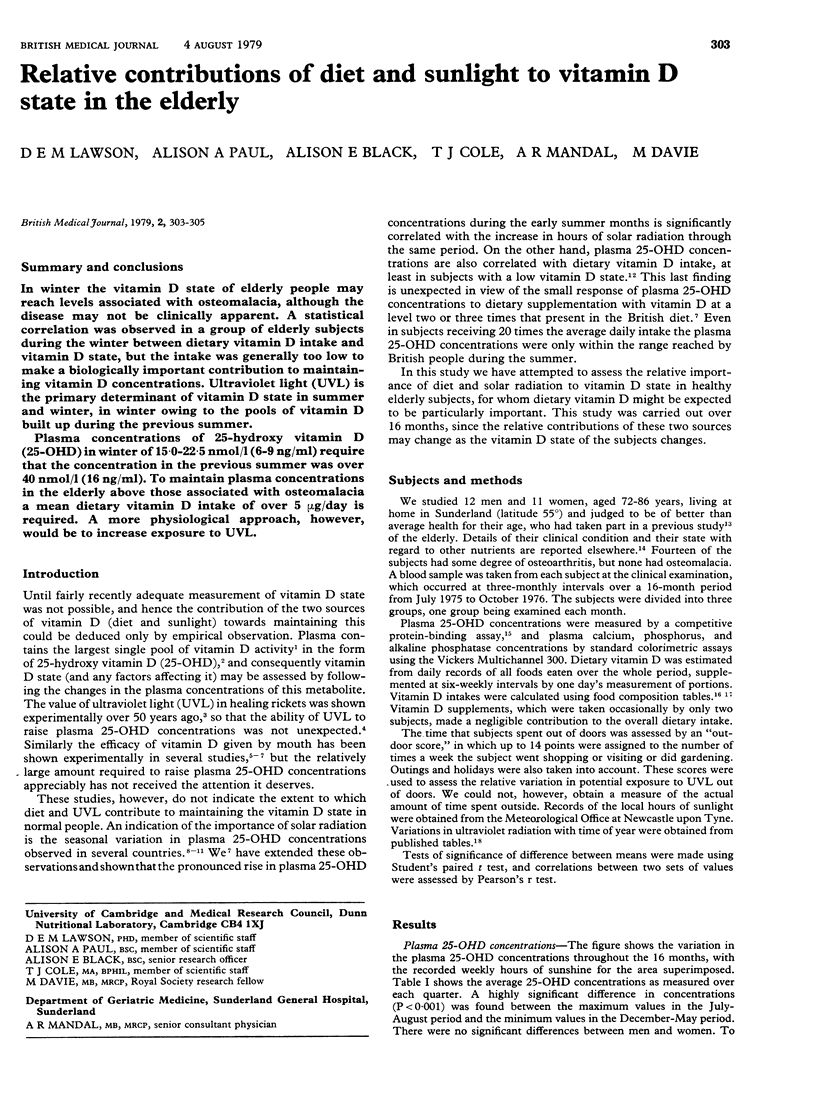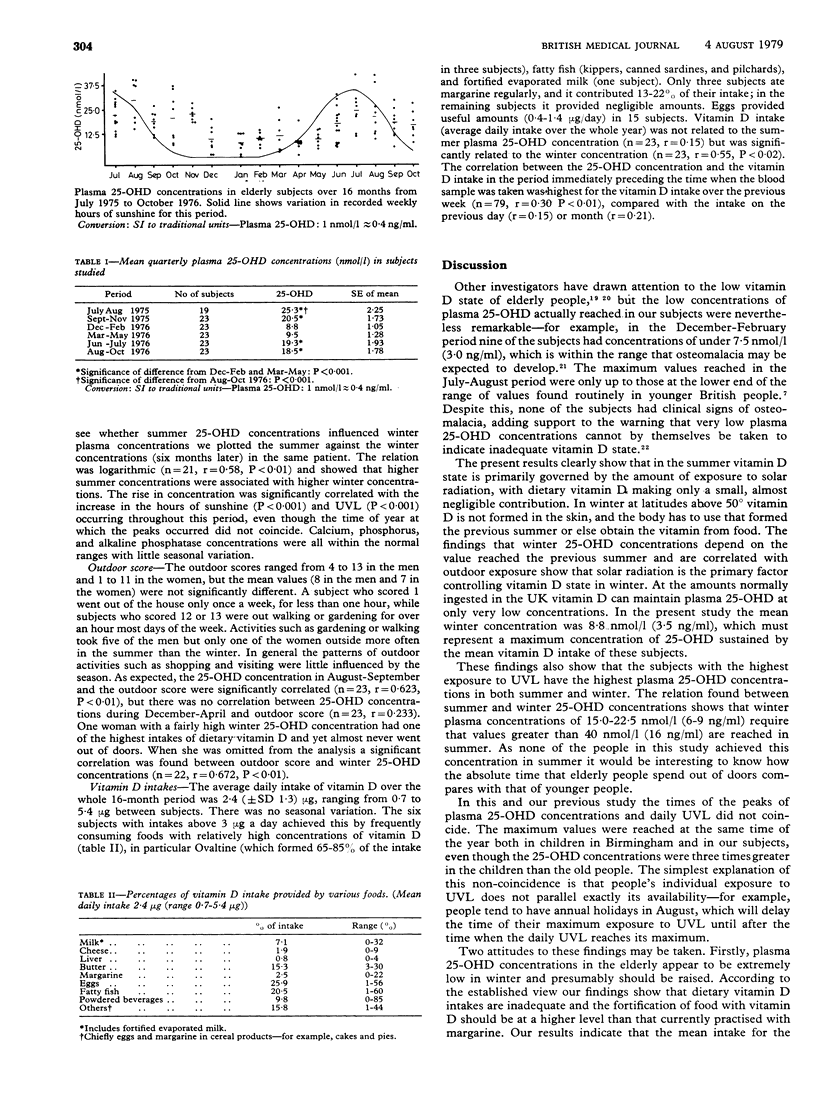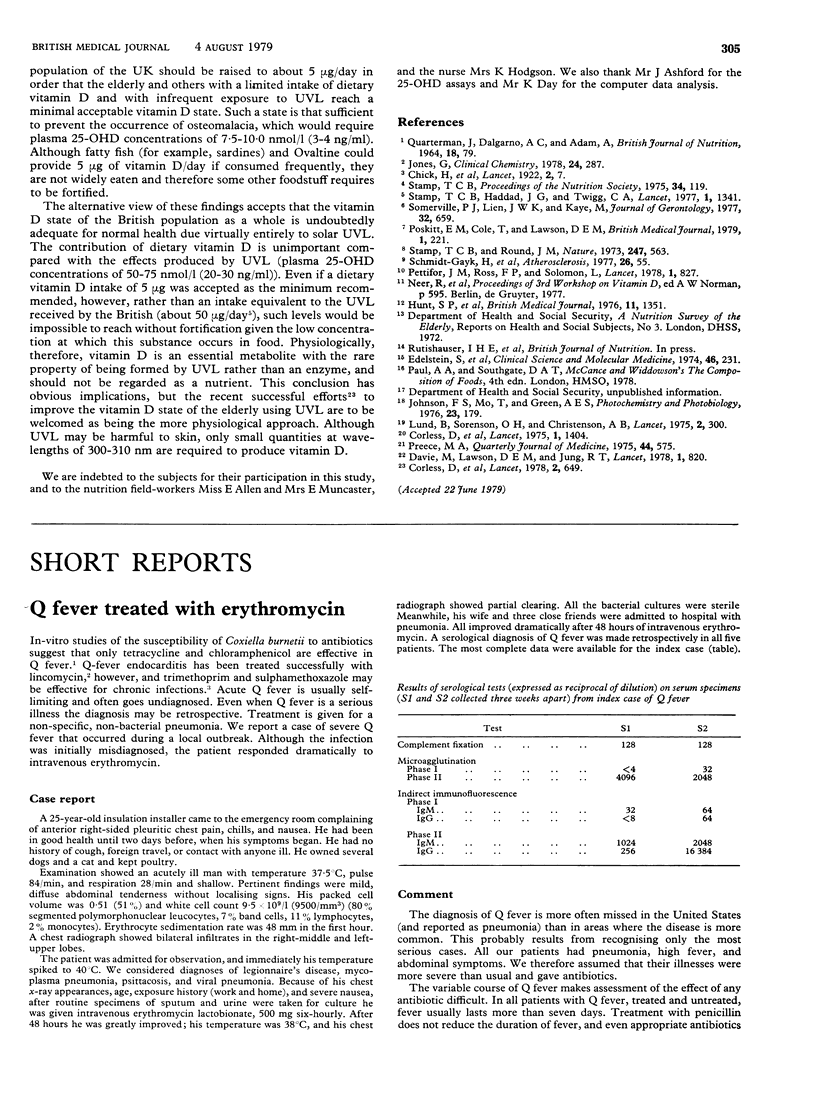Abstract
In winter the vitamin D state of elderly people may reach levels associated with osteomalacia, although the disease may not be clinically apparent. A statistical correlation was observed in a group of elderly subjects during the winter between dietary vitamin D intake and vitamin D state, but the intake was generally too low to make a biologically important contribution to maintaining vitamin D concentrations. Ultraviolet light (UVL) is the primary determinant of vitamin D state in summer and winter, in winter owing to the pools of vitamin D built up during the previous summer. Plasma concentrations of 25-hydroxy vitamin D (25-OHD) in winter of 15.0-22.5 nmol/l (6-9 ng/ml) require that the concentration in the previous summer was over 40 nmol/l (16 ng/ml). To maintain plasma concentrations in the elderly above those associated with osteomalacia a mean dietary vitamin D intake of over 5 microgram/day is required. A more physiological approach, however, would be to increase exposure to UVL.
Full text
PDF


Selected References
These references are in PubMed. This may not be the complete list of references from this article.
- Corless D., Boucher B. J., Cohen R. D., Beer M., Gupta S. P. Vitamin-D status in long-stay geriatric patients. Lancet. 1975 Jun 28;1(7922):1404–1406. doi: 10.1016/s0140-6736(75)92609-4. [DOI] [PubMed] [Google Scholar]
- Corless D., Gupta S. P., Switala S., Barragry J. M., Boucher B. J., Cohen R. D., Diffey B. L. Response of plasma-25-hydroxyvitamin D to ultraviolet irradiation in long-stay geriatric patients. Lancet. 1978 Sep 23;2(8091):649–651. doi: 10.1016/s0140-6736(78)92760-5. [DOI] [PubMed] [Google Scholar]
- Davie M., Lawson D. E., Jung R. T. Low plasma-25-hydroxyvitamin D without osteomalacia. Lancet. 1978 Apr 15;1(8068):820–820. doi: 10.1016/s0140-6736(78)93015-5. [DOI] [PubMed] [Google Scholar]
- Edelstein S., Charman M., Lawson D. E., Kodicek E. Competitive protein-binding assay for 25-hydroxycholecalciferol. Clin Sci Mol Med. 1974 Feb;46(2):231–240. doi: 10.1042/cs0460231. [DOI] [PubMed] [Google Scholar]
- Johnson F. S., Mo T., Green A. E. Average latitudinal variation in ultraviolet radiation at the earth's surface. Photochem Photobiol. 1976 Mar;23(3):179–188. doi: 10.1111/j.1751-1097.1976.tb07239.x. [DOI] [PubMed] [Google Scholar]
- Jones G. Assay of vitamins D2 and D3, and 25-hydroxyvitamins D2 and D3 in human plasma by high-performance liquid chromatography. Clin Chem. 1978 Feb;24(2):287–298. [PubMed] [Google Scholar]
- Lund B., Sorensen O. H., Christensen A. B. 25-Hydroxycholecaliferol and fractures of the proximal. Lancet. 1975 Aug 16;2(7929):300–302. doi: 10.1016/s0140-6736(75)92732-4. [DOI] [PubMed] [Google Scholar]
- Pettifor J. M., Ross F. P., Solomon L. Seasonal variation in serum 25-hydroxycholecalciferol concentrations in elderly South African patients with fractures of femoral neck. Br Med J. 1978 Apr 1;1(6116):826–827. doi: 10.1136/bmj.1.6116.826. [DOI] [PMC free article] [PubMed] [Google Scholar]
- Poskitt E. M., Cole T. J., Lawson D. E. Diet, sunlight, and 25-hydroxy vitamin D in healthy children and adults. Br Med J. 1979 Jan 27;1(6158):221–223. doi: 10.1136/bmj.1.6158.221. [DOI] [PMC free article] [PubMed] [Google Scholar]
- Preece M. A., TomlinsonS, Ribot C. A., Pietrek J., Korn H. T., Davies D. M., Ford J. A., Dunnigan M. G., O'Riordan J. L. Studies of vitamin D deficiency in man. Q J Med. 1975 Oct;44(176):575–589. [PubMed] [Google Scholar]
- Schmidt-Gayk H., Goossen J., Lendle F., Seidel D. Serum 25-hydroxycalciferol in myocardial infarction. Atherosclerosis. 1977 Jan;26(1):55–58. doi: 10.1016/0021-9150(77)90139-3. [DOI] [PubMed] [Google Scholar]
- Somerville P. J., Lien J. W., Kaye M. The calcium and vitamin D status in an elderly female population and their response to administered supplemental vitamin D3. J Gerontol. 1977 Nov;32(6):659–663. doi: 10.1093/geronj/32.6.659. [DOI] [PubMed] [Google Scholar]
- Stamp T. C. Factors in human vitamin D nutrition and in the production and cure of classical rickets. Proc Nutr Soc. 1975 Sep;34(2):119–130. doi: 10.1079/pns19750022. [DOI] [PubMed] [Google Scholar]
- Stamp T. C., Haddad J. G., Twigg C. A. Comparison of oral 25-hydroxycholecalciferol, vitamin D, and ultraviolet light as determinants of circulating 25-hydroxyvitamin D. Lancet. 1977 Jun 25;1(8026):1341–1343. doi: 10.1016/s0140-6736(77)92553-3. [DOI] [PubMed] [Google Scholar]
- Stamp T. C., Round J. M. Seasonal changes in human plasma levels of 25-hydroxyvitamin D. Nature. 1974 Feb 22;247(5442):563–565. doi: 10.1038/247563a0. [DOI] [PubMed] [Google Scholar]


